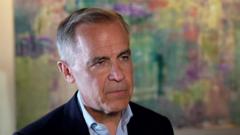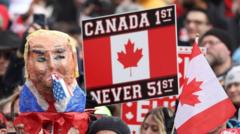After winning Canada's election, Prime Minister Mark Carney adopts a combative stance towards U.S. relations, focusing on sovereignty and trade wars, with an uncertain path ahead in Parliament.
# Mark Carney's Resounding Victory: What It Means for Canada's Future

# Mark Carney's Resounding Victory: What It Means for Canada's Future
Mark Carney's win signals a pivotal moment for Canada, as he prepares to challenge U.S. policies under President Trump while seeking unity within government.
Mark Carney of the Liberal Party has emerged victorious in the recent Canadian election, securing his position as Prime Minister amid a challenging political climate. With the election results tallied, Carney celebrated his party's narrow win that promises to uphold the Liberal agenda for the nation and counteract threats posed by U.S. President Donald Trump.
Upon his election on Monday, Carney emphasized the importance of standing firm against the U.S., particularly in light of Trump’s contentious comments that Canada might become the 51st state. In a rousing speech to his supporters in Ottawa, he made it clear that Canada would not yield its resources, land, or identity, highlighting the aggressive nature of American trade tactics under Trump.
As Carney assumes leadership, the key question remains whether his party will command a majority within the House of Commons. If not, he may face challenges in fulfilling his legislative goals without the support of smaller political factions. His approach will likely revolve around maintaining current tariffs against U.S. imports while balancing the impact on Canadian consumers and industries.
Despite having yet to meet Trump since taking office, Carney remains prepared to confront the U.S. leader’s policies directly. He has articulated that retaliatory measures will be sustained; however, he is mindful that stretching these could lead to adverse effects for Canadians.
Moving forward, Carney’s style of governance and ability to navigate complex international relationships will prove crucial in defining Canada’s trajectory amidst a backdrop of external pressures.





















